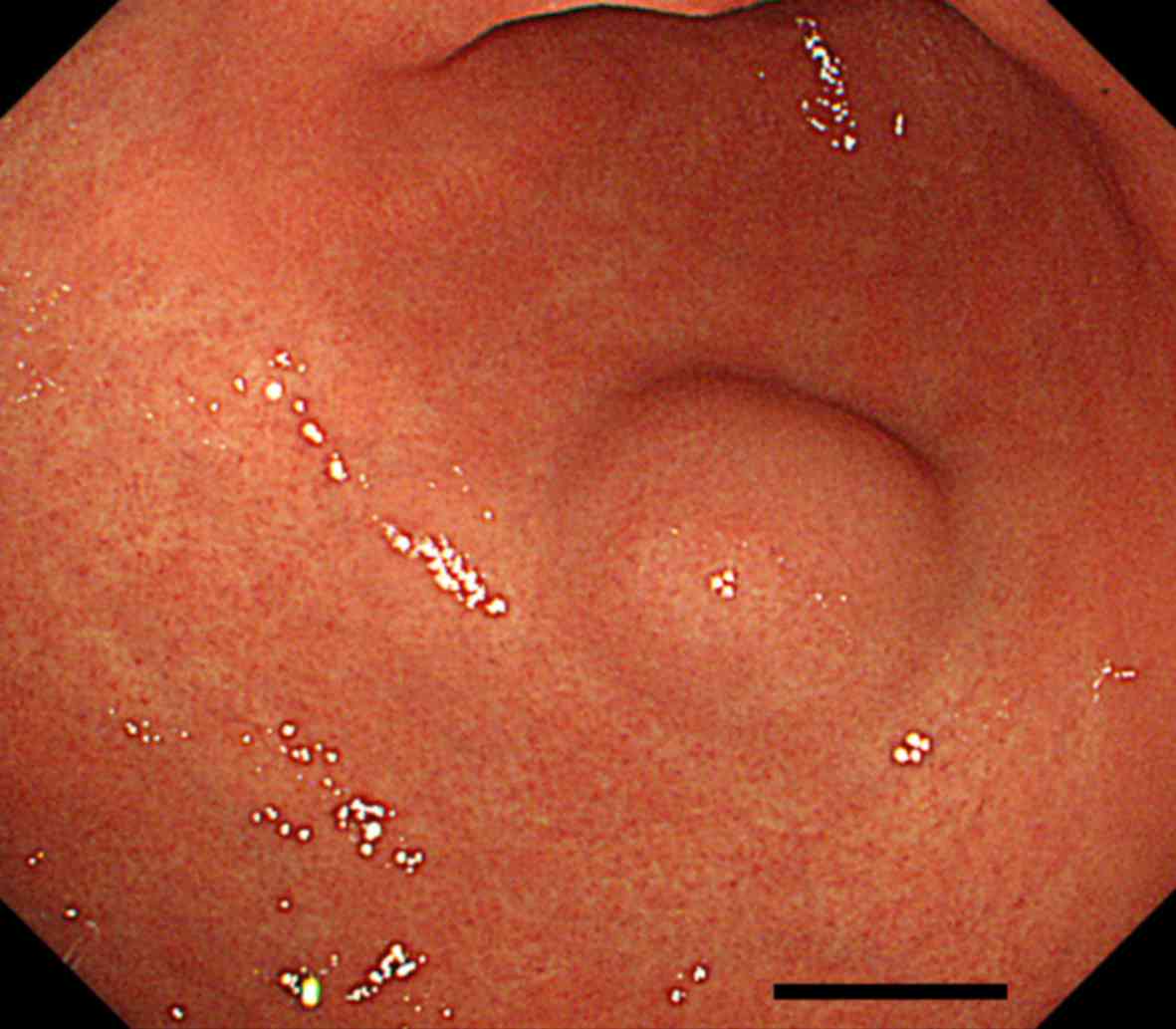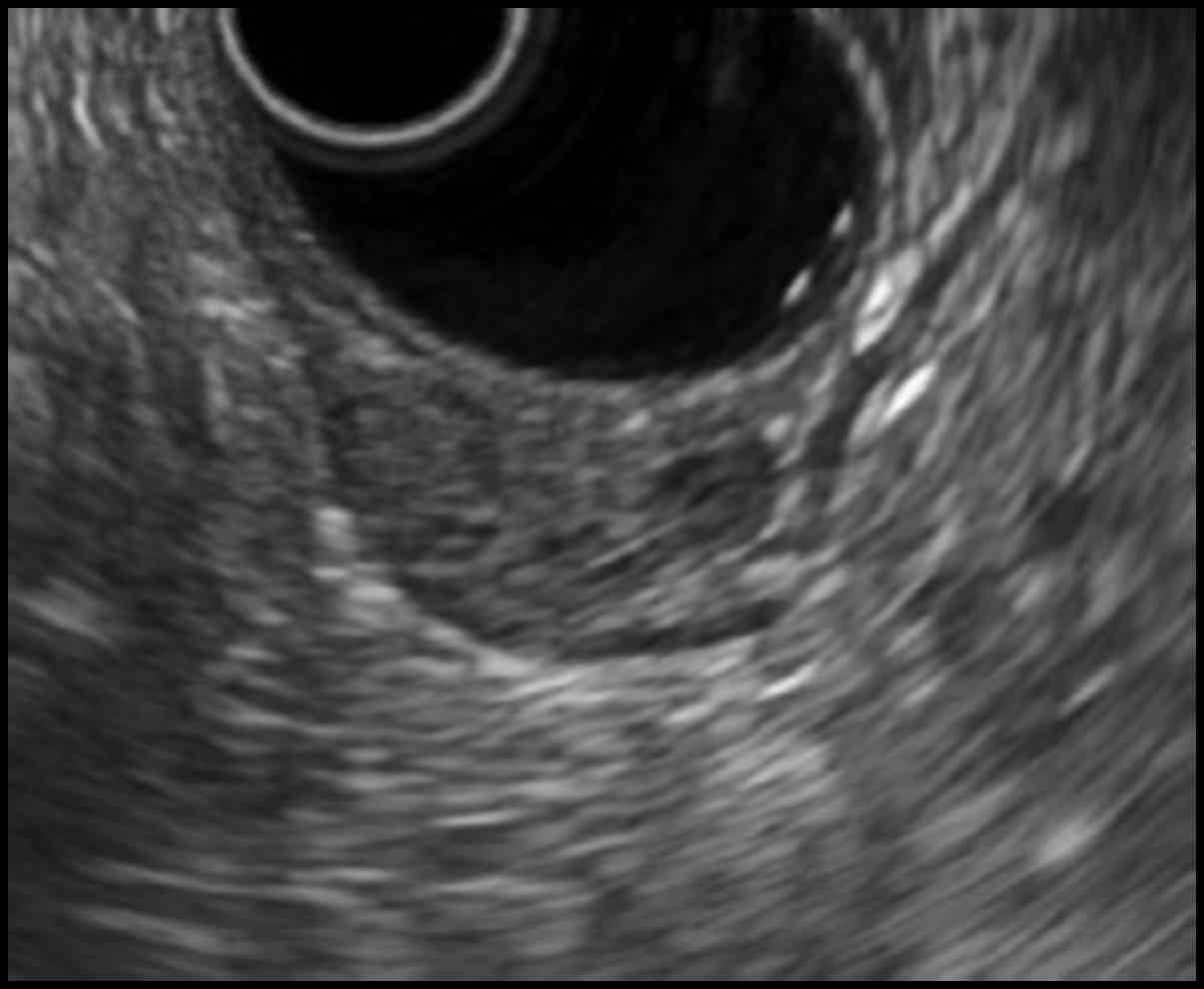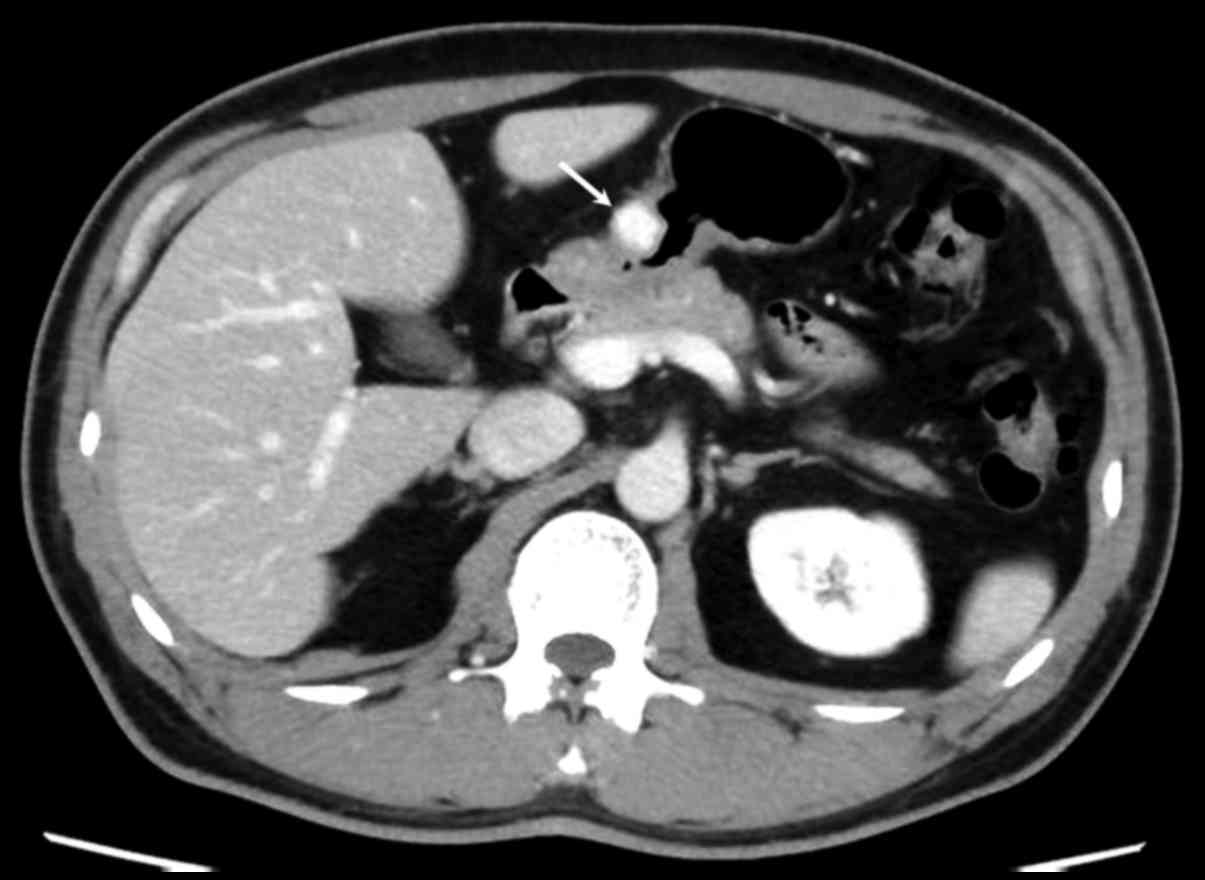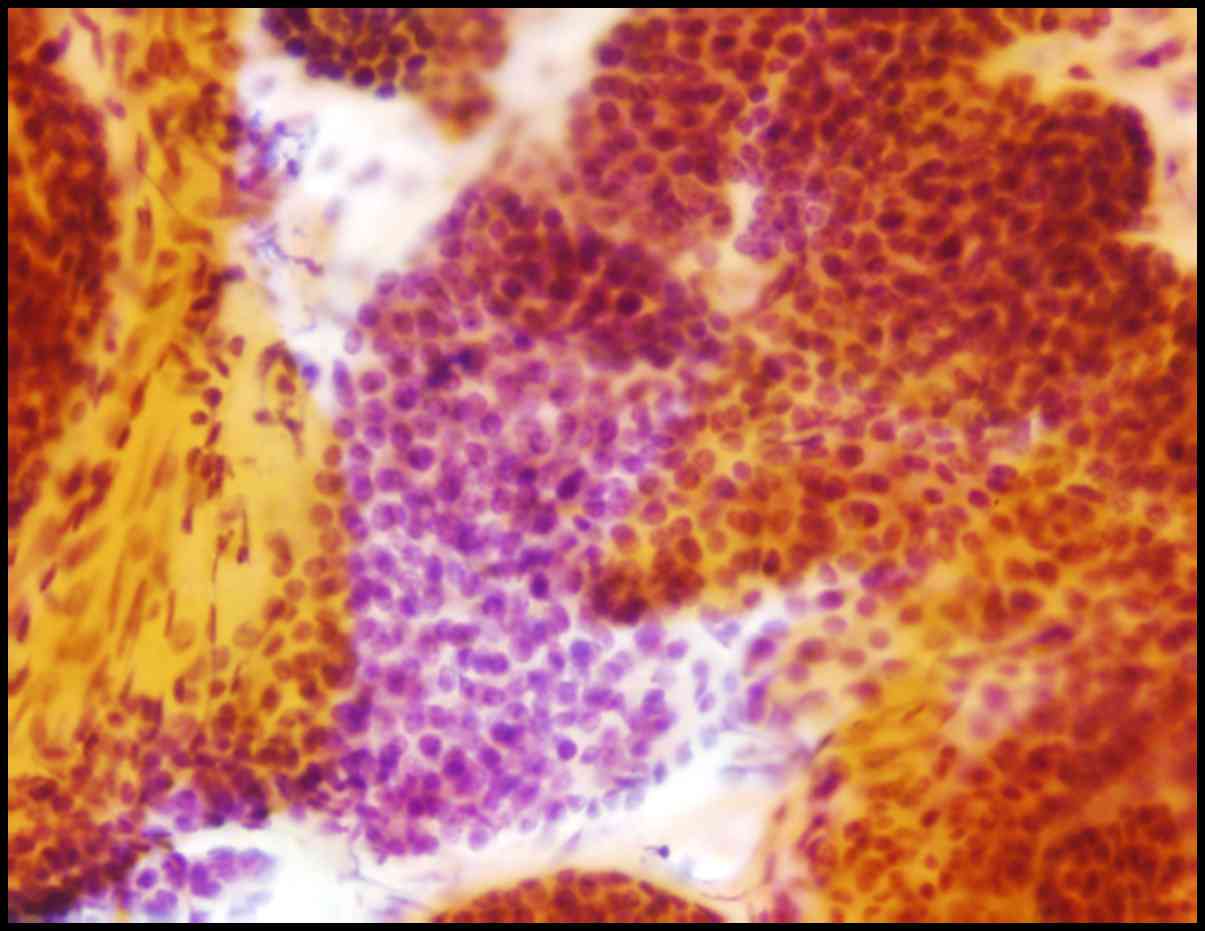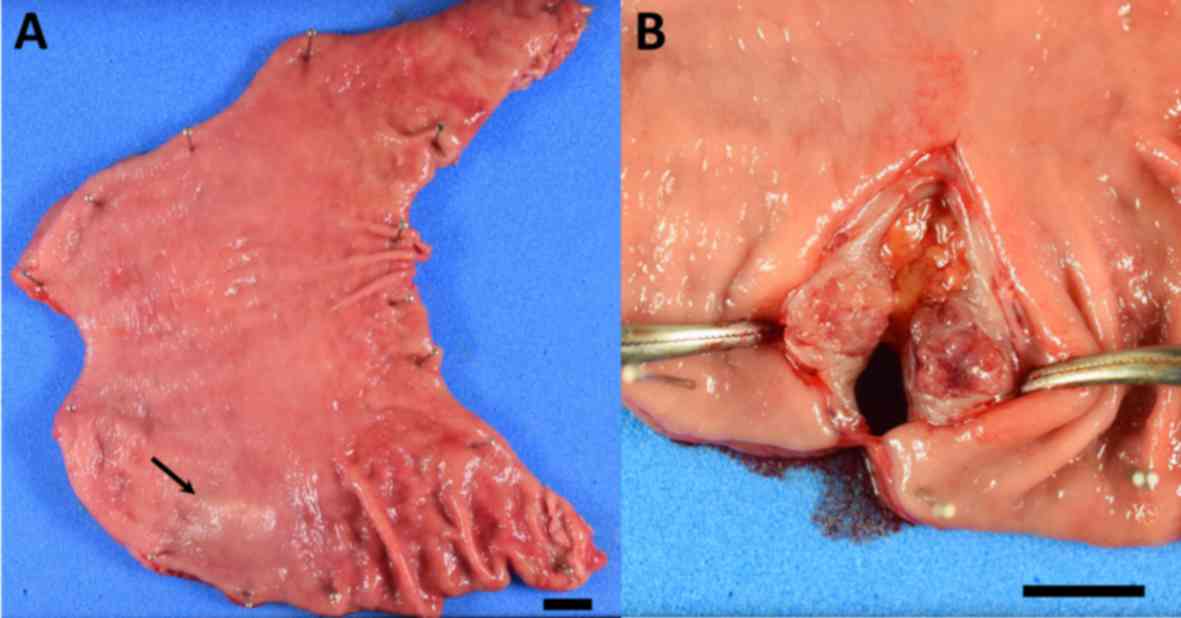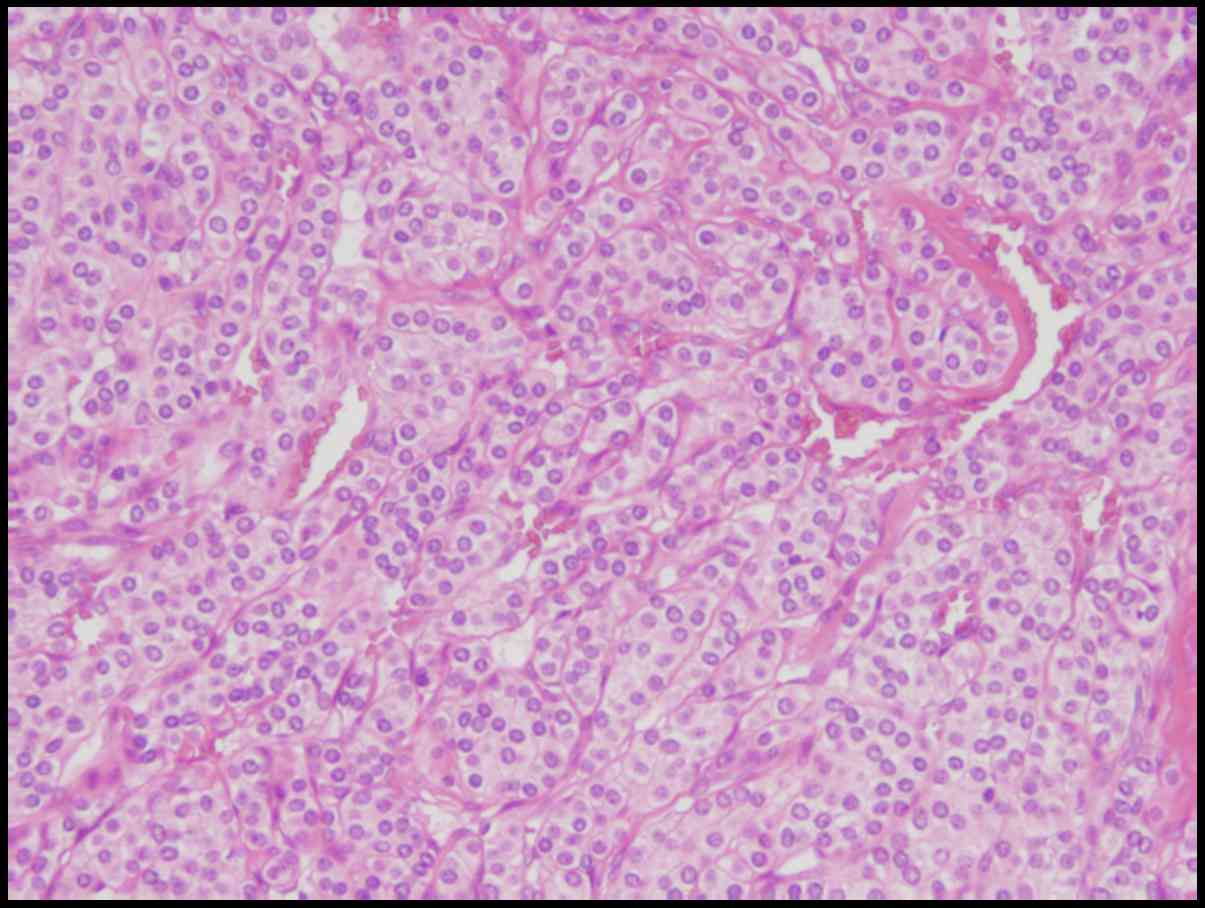Glomus tumor of the stomach treated by laparoscopic distal gastrectomy: A case report
- Authors:
- Published online on: October 25, 2018 https://doi.org/10.3892/ol.2018.9621
- Pages: 514-517
Abstract
Introduction
Glomus tumor is a mesenchymal neoplastic proliferation composed of modified smooth muscle cells arising from the perivascular structure called a glomus body (1). This tumor occurs most commonly in the peripheral soft tissues and extremities, and is seldom found in internal organs (2). Gastric glomus tumors are rare, with an estimated frequency of approximately 1% that of gastrointestinal stromal tumors (GISTs) (3,4).
In this report, we present a case of gastric glomus tumor in a 39-year-old male who was treated by a laparoscopic distal gastrectomy. The clinical characteristics of previously reported cases are also discussed.
Case report
A 39-year-old Japanese man was referred to our hospital for further examination of gastric submucosal tumor (SMT) diagnosed during a medical check-up. His past medical history and family history were unremarkable. The laboratory findings were almost within normal limits, as were serum levels of carcinoembryonic antigen and cancer antigen 19-9. Esophagogastroduodenoscopy (EGD) revealed a SMT of approximately 2 cm in size in the greater curvature side of the antrum (Fig. 1). Endoscopic ultrasonography (EUS) demonstrated a hypoechoic solid mass lesion with a small anechoic component in the third or fourth tissues layer, suggesting a lesion in the muscular layer of the stomach (Fig. 2).
Abdominal contrast-enhanced computed tomography revealed a 1.5-cm, well-defined mass lesion in the gastric antrum with strong, homogeneous enhancement in the early (Fig. 3). To obtain a definite diagnosis, EUS-guided fine-needle aspiration (EUS-FNA) was performed using a 22-gauge needle. The cytopathology smear of the lesion obtained by EUS-FNA revealed the proliferation of small, round to oval tumor cells with round nuclei and scant cytoplasm (Fig. 4). The patient underwent laparoscopic distal gastrectomy with reginal lymph node dissection under a clinical diagnosis of neuroendocrine neoplasm (NEN).
Gross examination of the surgically resected specimen showed a SMT (Fig. 5A, arrow) that appeared in cross-section as a well-circumscribed, solid tumor measuring 1.5×1.0 cm (Fig. 5B). Microscopical examination reveals solid proliferation of tumor cells with oval-shaped nuclei and scanty cytoplasm around the disorganized vessels in the submucosa and the muscular layer (Fig. 6). Immunohistochemical staining showed a positive signal for α-smooth muscle actin, but no staining for desmin, c-kit, CD34, S-100, chromogranin A, synaptophysin, and CD56. Approximately 1% of the cells were positive for the proliferation marker Ki-67. Therefore, we diagnosed a glomus tumor of the stomach. The postoperative course was uneventful, and he was discharged on postoperative day 10.
Discussion
Herein we describe a rare case of glomus tumor of the stomach treated by laparoscopic distal gastrectomy. In preparing this report, we searched for English-language articles on similar cases published from 2000 to 2016 in the Medline and PubMed databases, using the keywords ‘glomus tumor’, ‘stomach’, and ‘laparoscopy’ to obtain data on age, gender, tumor location, tumor size, depth of invasion, histological type, treatment, and outcome for each patient. To the best of our knowledge, this is only the seventh reported case of a gastric glomus tumor treated laparoscopically in the English literature.
Table I lists clinicopathological features of the six previously reported cases (1,3,5–8) and the present case. The median patient age was 50 (range 33–70 years), and the male-to-female ratio was 2:5. Gastric tumor in the lower third of the stomach was reported in six cases, with the remaining patient showing a lesion in the middle-third of the stomach. Treatment consisted of laparoscopic wedge resection in three patients, laparoscopic distal gastrectomy in two patients, laparoscopy and endoscopy cooperative surgery (LECS) in one patient, and non-exposed endoscopic wall inversion surgery in the remaining patient. The median tumor size was 1.6 cm (range 0.8–3.5 cm).
Table I.Clinicopathological data for reported cases of gastric glomus tumor treated laparoscopically. |
As gastric glomus tumor lacks specific clinical and endoscopic characteristics, it is difficult to distinguish them from the more common GIST or NEN including carcinoid tumor by conventional imaging (9,10). EUS-FNA is an effective method for obtaining pathological specimens of gastric SMT with a high rate of diagnostic accuracy (7). In the present case, the Giemsa staining of cytological smear obtained by EUS-FNA showed solid clusters of tumor cells with round nuclei and scant cytoplasm. On the basis of these histological findings, a preoperative diagnosis of a gastric NEN was made. However, because NEN comprises oval or spindle tumor cells arranged in cords or nests with thin-walled blood vessels, they can be extremely difficult to distinguish from glomus tumor. Consequently, a definitive diagnosis of gastric glomus tumors cannot be confirmed by standard endoscopy until histological results including immunohistochemical examination are considered (11,12). If the immunohistochemical staining of the specimens were performed, taking into the possibility of glomus tumor consideration, an accurate preoperative diagnosis might have been possible.
Complete resection of the lesion is necessary for accurate characterization and to treat the patient appropriately due to the possibility of malignant transformation, even though most glomus tumors are benign (11). Such efforts to treat SMT of the stomach have been improved by recent advances in endoscopic technique and devices that allow not only laparoscopic resection including LECS and non-exposed endoscopic wall-inversion surgery (NEWS), but also endoscopic resection (11,13).
In conclusion, although gastric glomus tumor is extremely rare, physicians should take this disease into consideration especially when SMT is observed in the lower third of the stomach. To avoid overtreatment of the glomus tumor, every effort including EUS-FNA and immunohistochemical examination must be carried out to make accurate diagnosis. Further studies and assessments by the accumulation of additional cases are needed to establish precise diagnostic criteria and to distinguish other diseases presenting as SMT of the stomach.
Acknowledgements
Not applicable.
Funding
No funding was received.
Availability of data and materials
The datasets during and/or analysed during the current study available from the corresponding author on reasonable request.
Authors' contributions
TN and MK designed the study. TN, ST, KF, JI, SU, ST, HM, HK, MK and KH acquired, analyzed and interpreted the data within the study. TN and KH finalized the manuscript and submitted the paper for publication. All authors edited the manuscript for intellectual content. All authors read and approved the final manuscript.
Ethics approval and consent to participate
Not applicable.
Patient consent for publication
Written informed consent was obtained from the patient for publication of this case report and any accompanying images.
Competing interests
The authors declare that they have no competing interests.
References
|
Ebi M, Sugiyama T, Yamamoto K, Saito T, Inoue T, Yamaguchi Y, Tamura Y, Izawa S, Hijikata Y, Funaki Y, et al: A gastric glomus tumor resected using non-exposed endoscopic wall-inversion surgery. Clin J Gastroenterol. 10:508–513. 2017. View Article : Google Scholar : PubMed/NCBI | |
|
Yamagata S, Shoji T, Kawashima S, Narasaka T, Sato S, Kawamura M, Matoba N and Wakasa H: Glomus tumor of the stomach. Tohoku J Exp Med. 78:202–208. 1962. View Article : Google Scholar : PubMed/NCBI | |
|
Minoda Y, Akahoshi K, Oya M, Kubokawa M, Motomura Y and Nakamura K: Gastric glomus tumor diagnosed by endoscopic ultrasound-guided fine-needle aspiration biopsy: Report of a case. Fukuoka Igaku Zasshi. 105:105–109. 2014.PubMed/NCBI | |
|
Miettinen M, Paal E, Lasota J and Sobin LH: Gastrointestinal glomus tumors: A clinicopathologic, immunohistochemical, and molecular genetic study of 32 cases. Am J Surg Pathol. 26:301–311. 2002. View Article : Google Scholar : PubMed/NCBI | |
|
Halawani HM, Khalife M, Safadi B, Rida K, Boulos F and Khalifeh F: Laparoscopic antral resection with Billroth I reconstruction for a gastric glomus tumor. Int J Surg Case Rep. 5:1128–1131. 2014. View Article : Google Scholar : PubMed/NCBI | |
|
Zhao XJ, Wang HH, Sheng JQ and Li N: Laparoscopic resection of a gastric glomangioma. Endoscopy. 46 Suppl 1 UCTN:E73–E74. 2014. View Article : Google Scholar : PubMed/NCBI | |
|
Kato S, Kikuchi K, Chinen K, Murakami T and Kunishima F: Diagnostic utility of endoscopic ultrasound-guided fine-needle aspiration biopsy for glomus tumor of the stomach. World J Gastroenterol. 21:7052–7058. 2015. View Article : Google Scholar : PubMed/NCBI | |
|
Castro Ruiz C, Carlinfante G, Zizzo M, Giunta A, Ronzoni R, Azzolini F and Pedrazzoli C: Glomus tumor of the stomach: GI image. J Gastrointest Surg. 21:1099–1101. 2017. View Article : Google Scholar : PubMed/NCBI | |
|
Lin YM, Chiu NC, Li AF, Liu CA, Chou YH and Chiou YY: Unusual gastric tumors and tumor-like lesions: Radiological with pathological correlation and literature review. World J Gastroenterol. 23:2493–2504. 2017. View Article : Google Scholar : PubMed/NCBI | |
|
Papadelis A, Brooks CJ and Albaran RG: Gastric glomus tumor. J Surg Case Rep. 2016(pii): rjw1832016. View Article : Google Scholar : PubMed/NCBI | |
|
Zhang Y, Zhou P, Xu M, Chen W, Li Q, Ji Y and Yao L: Endoscopic diagnosis and treatment of gastric glomus tumors. Gastrointest Endosc. 73:371–375. 2011. View Article : Google Scholar : PubMed/NCBI | |
|
Baek YH, Choi SR, Lee BE and Kim GH: Gastric glomus tumor: Analysis of endosonographic characteristics and computed tomographic findings. Dig Endosc. 25:80–83. 2013. View Article : Google Scholar : PubMed/NCBI | |
|
Namikawa T and Hanazaki K: Laparoscopic endoscopic cooperative surgery as a minimally invasive treatment for gastric submucosal tumor. World J Gastrointest Endosc. 7:1150–1156. 2015. View Article : Google Scholar : PubMed/NCBI |



